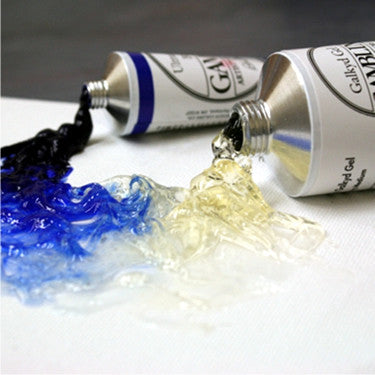
Oil paints contain only two components: dry particles of colour (the pigment) and liquid oil (the vehicle), smoothly blended to a thick paste-like consistency. By adding a thinner or medium to the oil vehicle, you can hugely alter it's working properties (such as body, sheen, and drying time), making oils a very versatile medium. With a large array of mediums and thinners available, choosing the right one for your needs can be confusing and even intimidating, but it doesn't have to be!
What is a Medium?

Mediums are mixed into oil paints mainly to change the body (working consistency) or the drying time. Mediums come in many consistencies; they can be very fluid (like water) or very thick (like a gel). Mediums are not at all useful for cleaning up oil paint, however, applying an oil medium to natural brushes (after cleaning them) helps prevent the bristles from drying out and breaking down over time.
What is a Thinner/Solvent?

Solvents/thinners can be mixed directly into the oil paint to flatten the body (thin it down). Solvents are also used for thinning mediums and for dissolving resin crystals & waxes (creating you own custom varnishes). Thinners are great for cleaning paint off of everything from brushes, to your studio, and yourself.
Traditionally, solvents were products made from natural sources (such as pine sap or citrus) and thinners were synthetic variations, however the lines have become blurred in recent decades so don't get too hung up on names.
When to Thin Oil Paints

For traditional oil painting, the golden rule is to work "fat over lean"... this means that the first (bottom) layers of your painting should be heavily thinned. As you add subsequent layers of paint, you add less and less thinner/medium until the very last (top) layers which can be painted with colour straight from the tube.
Oil paint is extremely thirsty (absorbent) as it goes through the drying process. If your first layers are too thick, they will draw in all the oil from subsequent layers, making the colours "sink-in" and become dull and lifeless.
An Important Word on Combustibility
Some Common Mediums
Linseed Oil:

Linseed oil is a golden yellow oil that comes from the cold pressing of flax seed.
- the most widely used oil medium
- suitable for glazing
- will extend oil paints without sacrificing viscosity
- dries to a high sheen
- doesn't noticeably affect drying times one way or the other (about a week to be dry to the touch)
Potential Pitfalls:
- tends to become more yellow over time
- can become brittle or craze (crack) over time
- can darken over time if not exposed to sunlight (if painting is stored in the dark, for example)
Stand Oil:

Stand oil is linseed oil that has been heated to 300°C in an oxygen free environment, causing the oil to thicken substantially.
- very thick and viscous
- strong self-leveling properties
- when glazing, it creates a smooth enamel-like film
- less prone to yellowing than regular linseed
- can darken over time if not exposed to sunlight (if painting is stored in the dark, for example)
- too viscous to function as a binder, so it's not suitable for paint-making with dry pigments
Eco-House stand Oil
Walnut Oil:

A pale yellow-brown oil made from walnuts which naturally contain about 65% oil.
- a thin oil
- ideal for thinning pale colors
- less prone to yellowing than linseed oil
- compatible with other mediums and oils
- dries in 5-6 days
- certified nontoxic.
Alkyd Walnut Oil:

A dark-amber coloured, concentrated Walnut oil.
- accelerates drying
- dries in 3-4 days
- enhances adhesion between layers
- increases surface sheen and flexibility
- best suited for alla-prima and glaze applications.
- compatible with other mediums and oils
- certified nontoxic.
Potential Pitfalls:
- the label on the Alkyd oil indicates it's "non-yellowing", however opinions are mixed.
Thick, Fast-Drying Mediums:

Liquin, Neo Megilp, and Res-N-Gel are three examples of the same thing, (from three different manufacturers); a thick, gelatinous medium that also speeds drying time.
- fast drying
- ideal for deep texture and impasto techniques
- extends paint without sacrificing body
- creates flexible films and increases surface sheen
- all are considered non-yellowing formulas
Potential Pitfalls:
- some are so very fast drying that they're not ideal for glazing large areas
- Liquin specifically has a cool (bluish-purplish) tone to it which can be noticeable in some cases; Liquin is also prone to darkening over time.
Martin F. Weber Res-N-Gel
Cold Wax Medium:
A thick solution of refined white bees wax dissolved in solvent.
- a very thick, paste-like medium
- great for deeply textured impasto effects
- cuts the gloss and imparts a satin finish, often with a granular or pebbly texture
- slow drying medium
- can be used as a sealant for mixed media; thin applications can be gently buffed once dry for a more smooth and glossy finish
Potential Pitfalls:
- film prone to cracking/crazing; recommended for rigid substrates only
Poppyseed Oil:

Extracted from cold pressed poppy seeds.
- a very thin oil
- very pale in colour
- ideal for mixing/making whites and other lighter colours
- slow drying
- high gloss film
Potential Pitfalls:
- slows drying time considerably!
- creates a thin, often brittle film with a strong potential for crazing/cracking with time
Some Common Thinners & Solvents
Turpentine (Pure Gum Spirits):

A distillate from pine tree resin. NOTE: Use only Artist grade; industrial grade turpentine (which can be found at hardware stores) is produced from waste wood and contains impurities, and also has a strongly unpleasant odour.
- high strength thinner
- the most traditionally used oil solvent
- strong odour and harmful vapours
- the ideal (and only) solvent capable of dissolving damar resin crystals
- increases film flexibility
- after evaporation, a (harmless) gummy residue is left behind
- should be used "fresh"; turpentine can go off
OMS (Odourless Mineral Spirits):

A petroleum distillate whose working properties mimic turpentine.
- odourless; good option for people with sensitivities
- long life-span; doesn't go off
- free of gummy residue after drying
- although you can't smell it, OMS still release harmful vapours
DL Stevenson's OMS
Gamblin Gamsol (OMS)
Odourless Turpenoid:

Is a highly refined petroleum based substitute for turpentine.
- has same painting properties and drying time as turpentine
- free from the strong turpentine odour
- chemically, has more in common with OMS than turpentine.
Turpenoid Natural:

A highly refined citrus based substitute for turpentine.
- strong citrus odour
- used for thinning paint and for cleaning brushes etc
- non-toxic and environmentally friendly
- a good option for people with chemical sensitivities
Citrus Thinner:

A citrus distillate; a byproduct of the manufacturing of citrus peel liquor.
- an extra-mild thinner (not a s strong as turpentine; not strong enough to dissolve resin crystals)
- yellow-ish in colour
- strong citrus odour
- used for thinning paint and for cleaning brushes etc
- speeds drying
- environmentally friendly
- a good option for people with chemical sensitivities
Soy Thinner:

A mixture of petroleum distillates and refined soy additives.
- light amber in colour
- medium-high strength thinner (stronger than citrus; useful for thinning already dissolved resins)
- low odour
- vapors are less harmful than OMS or a traditional turpentine
- has a greasy viscosity that makes it ideal for cleaning & conditioning brushes






